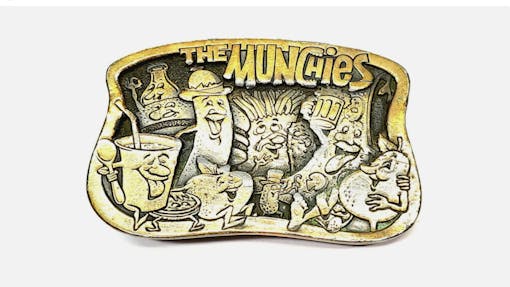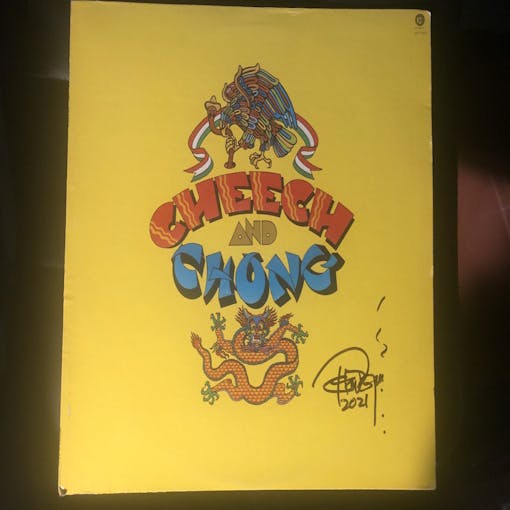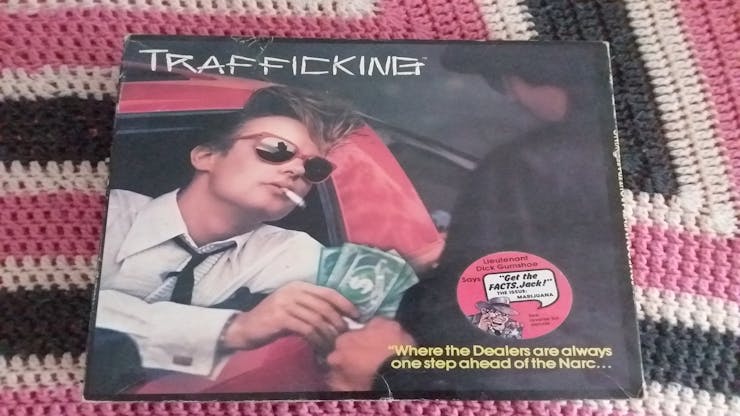Weed memorabilia has come a long way from chillum pipes and “drug rug” sweatshirts. As cannabis and weed-adjacent companies embrace progressive legislation and slick branding, consumers and weed lovers are rushing to save all those trinkets from the increasingly bygone era of prohibition.
Treasured by collectors for historical and personal value, prohibition-era marijuana memorabilia immortalizes a time we’ll (hopefully) never see again.
Buckle puffers smoked at Woodstock
Jake Fulteron has been on a quest to replace the handmade, hippie belt buckle pipe he lost at the 1969 Woodstock music festival, an endeavour that has amounted to “about 900 pounds of brass” in the form of buckle pipes, also called “buckle puffers.”
He explains that “they sold these buckle puffers on lanyards. I ended up with a buckle puffer, they weren’t called that then, [and] I lost it. I spent a lifetime trying to get it back. It was a quest. I searched for decades.”


A year ago, Fulteron finally tracked down one of these elusive buckle puffers: “it was in front of me, and I was like ‘that’s my pipe.’ I know what the hippie filigrees are—I have 40.” He estimates he has around 1,000 buckles total.
His fascination with the buckles comes from the work put into them.
“These pipes are art made out of necessity for people who wanted to be free. The craft is an art.” He’s honed his eye to the point he can distinguish buckles by their workmanship.
Jake Fulteron
“There’s a difference between the ‘60s buckles and the ‘70s buckles, and it’s distinct. The marijuana buckles in the ‘60s were all handmade, the ‘70s are more mass-produced.”
From there, Fulteron’s vast knowledge of cannabis-inspired collectibles has taken him from the niche buckles into snatching up ephemera from all aspects of the headshops.
“I went all out, buying up old posters, clothes, spoons, buckles, everything. I managed to get my hands on the wholesale dealer catalogues that were for headshops. It’s hundreds of pages of everything that was for supplying a headshop. Then I knew what to go after.”

Their illegality and small print runs make tracking down these toker treasures challenging, so the finds are serendipitous when they do happen. Fulerton also sees parallels in how culture increasingly values items and mementos from repressive eras.
“I really think this is an interesting subject, people collect alcohol prohibition-era items. They buy whole bars and speakeasies.”
Prohibition’s racist legacy
Another of Domer’s finds is Emily Murphy’s 1922 book, The Black Candle, often cited as fear-mongering, racist propaganda that drummed up support for opium and cannabis prohibition.
“[It’s] like if your grandmother had never seen or touched drugs, but wrote a book about it. Today it would be called Fake News,” he says.
The Black Candle is an excellent example of racism disguised as prohibition propaganda that resulted in grievous harm to minorities, in particular Asian Canadians who bore the brunt of The Opium Act penalties. Collectors could pick up this first printing for approximately $90.

“Cannabis prohibition is firmly rooted in racism,” explains Abi Sampson, a Centennial College professor of Cannabis Regulation. “Drug criminalization began as a means to control Japanese and Chinese people who were here working on the railroad. They faced rampant racism and xenophobia that led to The Opium Act. Emily Murphy’s book came out, and the anti-Asian sentiments were translated into her book.”
Even pro-cannabis items from back in the day may have uncomfortable racist overtones. The Great American Buckle Co. pot series belt buckle is a unique ‘70s cannabis cultural item, but designed with stereotypes in mind. One, called “Vietnameese,” shows a caricature of an Asian man smoking a joint with chopsticks.
“I view this as a piece of memorabilia. It totally encapsulates the racism of the times. It’s an example of how stigmatization is propagated in popular media and fashion,” said Sampson, who compared the buckle to other uncomfortable popular culture.

“It’s kind of like how people can be really enthusiastic about Dukes Hazards, you can be a huge fan, but know not to fly the Confederate flag.”
The “Vietnameese” buckle has a historical value that Sampson said, “I feel this would have a home in Amsterdam’s Hash and Marihuana Museum. It’s part of cannabis culture and the history of where we came from.”
The making of a marijuana museum
Many marijuana memorabilia collectors are inspired by the items’ historical connection, and some collections become so large that they become museums.
Sensi Seeds founder Ben Dronkers has established museums in Amsterdam and Barcelona, and the prized collection includes a 1660 painting by artist David Teniers (The Younger) of people sitting around a table smoking cannabis.
Domer uses the items from his memorabilia stash to tell a localized prohibition story. “I didn’t try to build a collection,” he said, “I just had some neat and interesting things. I wanted to find some interesting artifacts that relate to cannabis and Calgary. It has a personal cache.”
Like his autographed, original Cheech & Chong vinyl, which Domer had Tommy personally sign after the journalist tracked down the first place Chong ever smoked weed. Hint, it’s in Calgary, but required some serious investigative research because Tommy misremembered the venue’s name.

Finding illegal lit literature in North America
Journalist and cannabis tour guide Dave Domer scored an original 1974 handmade cannabis grow guide, Grow Yer Own Stone by Dr. Alexander Sumach, from his uncle. It has been collecting dust in a drawer.
“He was moving and packing his house up,” Domer says. “He emailed to say he found something for me. I met him for breakfast and he pulled out an original copy of Grow Yer Own Stone.”
The 1974 Grow Yer Own Stone would be akin to owning Spiderman’s first appearance (Amazing Fantasy #15) because it documents Canada’s first steps towards legalization.
The book’s ganja goony art style would go on to be an international success with thirteen printings; it’s currently valued by book collectors at about $175 – $250 CAD.
In the 1990s, Dr. Sumach testified before the Canadian Senate about hemp’s commercial crop value. His testimony contributed to Canada beginning limited hemp growing exemptions.

Digging through a bin of games in a grubby rural ‘treasure’ shop, I serendipitously discovered another Dr. Sumach collaboration—The Underground Games Company 1983 Trafficking board game—complete with the pamphlet from Ontario’s Addiction Research Foundation titled “Marijuana: Answers for Young People and Parents.”
The owner was unaware they had it, and eagerly accepted twenty dollars. The Canadian game captures the ‘80s Toronto weed dealing vibe beautifully, satirizing landmarks and logos with a fine toker brush.
Trafficking’s arrival comes in a unique period in Canada’s drug war history because, in 1988, the Conservative government proclaimed Criminal Code 462.2, which made even owning a book about weed a crime.
DID YOU KNOW:
During the late 80s, stoners couldn’t even own NORML Canada literature, and it wasn’t until their pivotal 1994 court ruling that Gen X could openly talk pot and purchase Grow Yer Own Stone legally. The ruling is Canada’s first crack in prohibition and put us on the road to using the courts for effecting change.
Modern mementos and legacy items
Marijuana memorabilia doesn’t have to be old to be considered collectible. Take the first iterations of Canada’s cannabis branding. How many people have kept their Canadian legacy-era product packaging?
Cannabis seed collectors love their packaging too, and @goshenthegreen has not just some great packaging from breeders like TGA Subcool, DJ Short, and Oaksterdam clone catalogues from the 2000s.

I personally collect seed packs and catalogues, and I’m really missing Canadian breeder Willy Jack Seeds, who was very popular during the 2000s. These packs have a personal cache because the cops cleared out my extensive Willy Jack Seeds collection when my home was raided. (People collect the seeds too, but that’s a whole other conversation.)
Cannabis collectors and their hoards of history help us remember our prohibitionist past and the vibrant subculture that existed despite the illegality.
As we settle into legalization, history is still unfolding in yard sales, retail thrift shops, cannabis groups, and online seller sites like eBay, waiting for you to find a piece.





